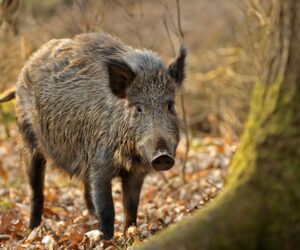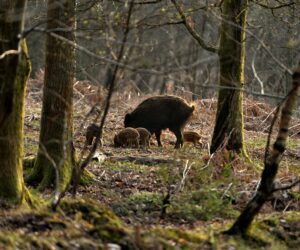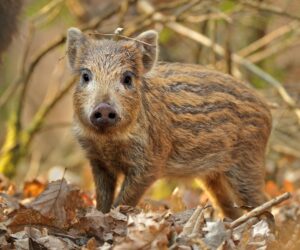Wild boar are part of the pig family. They became extinct in the UK around the 13th Century due to over-hunting and habitat loss. Wild boar populations in Scotland are believed to originate from escapees from private collections and farms, as well as illegal releases. NatureScot refer to wild boar as ‘feral pigs’.
Their fur varies from dark grey to black or brown and consists of stiff bristles and finer fur. Adult males develop formidable tusks which can grow up to 12cm in length. Piglets have a different colouring to adults which changes as they grow older. They have a chocolate coloured coat with cream, lengthwise stripes over their bodies.
Behaviour
Wild boar are primarily nocturnal animals and are omnivorous. They will eat a large variety of food items, although around 90% of their diet is made up of plant material. Wild boar root through soil to find their preferred foods. Although this rooting can appear destructive, it has many benefits for biodiversity, creating areas of exposed soil ideal for burrowing insects and the germination of seeds for a variety of plants and trees. These exposed areas are also good places for birds to feed on the insects present. Wild boar feeding also helps keep fast growing plants, like bracken, from taking over an area giving other plant species a chance to grow.
They have exceptional hearing and sense of smell but they have very poor eyesight. Wild boar are very vocal and communicate through grunts and squeals. Adult males are usually solitary, but females and their offspring live in groups called ‘sounders’.
Size
- Length: 1.5m
- Height: 60-80cm at the shoulder
- Weight: 200kg
- Average Lifespan: 15 – 20 years
Status
Least concern.
Distribution
Can be found throughout mainland Europe and parts of central Asia. Some localised populations in Scotland.
When to see
Throughout the year in areas where they are present
Facts
- Wild boar hair used to be used for making toothbrushes until the invention of synthetic materials in the 1930s.
- During the summer months, boar take mud baths to help keep cool. By creating wallows, wild boar can create wet and boggy areas that attract amphibians and dragonflies.



